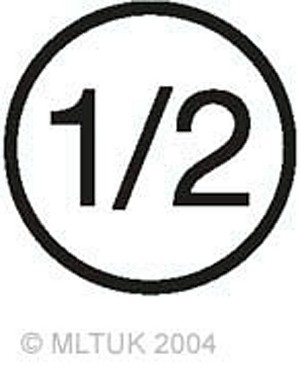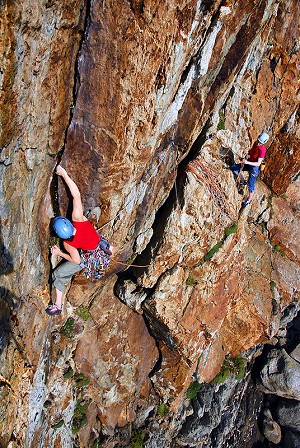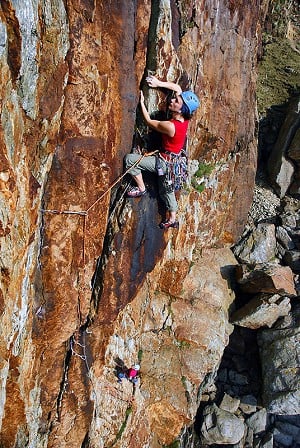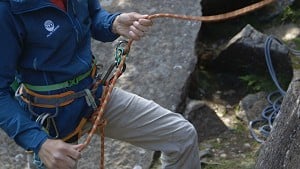

The Get Out On Rock DVD (pictured right) is a collaboration between Neil Gresham (top-level climber and Britain foremost coach) and Libby Peter (experienced Mountain Guide and climbing Instructor). It brings you the very latest in rock climbing skills and techniques and provides instruction and inspiration whether you're venturing onto rock for the first time or getting more adventurous with your climbing.
The DVD is available from: Libby Peter's Website
Are you confused about which ropes to take to the crag? Do you know the difference between a half rope and a full rope? Do double ropes sometimes seem like more trouble than they're worth? If this is you and you're getting sweaty with your rope spaghetti, read on and we'll do our best to makes sense of it all.


Double ropes should more correctly be referred to as half ropes. They are designed to be used as one of a pair - both ropes run alongside each other from the belayer to the climber (hence the term double rope technique, and hence why most belay plates have two slots in) and this dictates how the ropes are constructed and tested.
In the past climbers have referred to 9mm and 11mm ropes, which used to describe the diameter of half and single ropes respectively, but now the diameter range is so wide (we have some very thin single ropes!) and overlaps between half and single ropes so it's important to check the rope's classification.
The end of a half rope will carry the symbol shown on the right.
When should you use them?
Most folk start off with a single rope that they can use in the climbing wall and also for sport (bolt protected) climbing and on simple single pitch routes. A single rope will also do you for straightforward multi-pitch climbs, but once you start venturing onto more complex multi-pitch routes and in particular in places where you may need to make long abseil descents that's the time to consider investing in some half ropes.
Why and where
Double ropes come into their own on multi-pitch climbs or more complex longer single pitches that weave around. The advantages of double rope technique can be seen clearly in these photos of Lou Neill on The Sun, E3 5c, Rhoscolyn, shown below.
As Lou traverses away from the belay she's placed a high runner on the blue rope (her right hand rope). When she pulls into the strenuous corner she wants a runner quickly and already knows she'll clip this on red.
She'll carry on clipping the red rope until she's high enough to be back in line above the early runner on blue so it won't give her any rope drag.
Much higher up the pitch now you can see Lou has managed to keep the two ropes separate and both running smoothly. She has placed plenty of runners but has avoided creating any rope drag.
Photo Gallery - Lou Neil on The Sun :
How
The basic idea of double rope techniques is to have a left and right hand rope that work for you independently and which you clip according to the position of the runner. If the route is direct and all the gear central, such as on a continuous crack pitch, the ropes can be clipped alternately. This way you're nicely protected by the previous runner, that's on the other rope, as you pull up an armful of slack to clip.
If the pitch slants diagonally or meanders around clip left or right accordingly and try to keep a picture of what line the ropes are taking. This is best done by taking the time to stop, and look back down the pitch from time to time. Often your belayer will have a better overall view of the line of the pitch and can help you out.
The theory of double rope technique is simple but in practise it's incredibly difficult to get it right. Normally because you're pre-occupied with more immediate problems like route finding and not falling off. If you're new to double ropes try them out on some routes well within your leading grade first, or even a route you've climbed before so there are no nasty surprises. Equally as important is to be sure your belayer is comfortable with the added complexity of paying out two ropes – it takes some practise so start off gently.
You can see a practical demonstration of the benefits of double ropes in this clip:
VIDEO: Moving on with Leading; Double ropes
And Finally
Don't confuse half-ropes with twin-ropes. Twin-ropes are even thinner than half-ropes and are designed to be used as a pair but when both ropes are to be clipped into every runner. We don't use them much in the UK as they intended for long mixed or ice lines where you want the simplicity of clipping both ropes together but the added security of the increases abrasion resistance and abseil potential of two ropes.
- ARTICLE: My Favourite Route - Cemetery Gates by Libby Peter 23 Dec, 2024
- VIDEO: How to Protect Traverses 24 May, 2010
- Surviving Sea-cliff Adventures 8 Apr, 2010
- VIDEO: How to rig an abseil 1 Apr, 2010
- VIDEO: How to equalise anchors at a belay 12 Mar, 2010
- VIDEO: How To Rig a Top Rope 3 Mar, 2010



















Comments